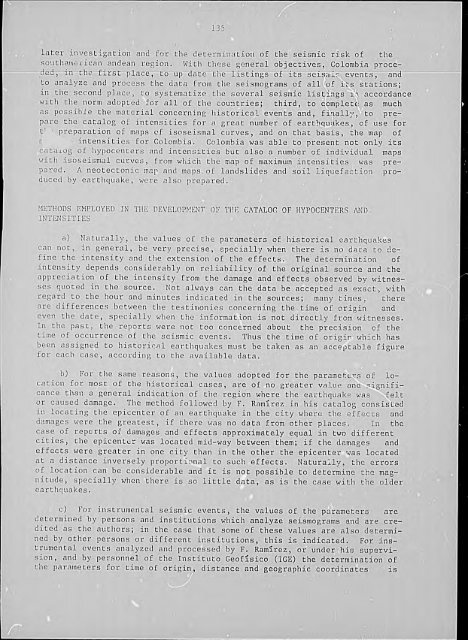catalogo de terremotos para america del sur catalog of earthquakes ...
catalogo de terremotos para america del sur catalog of earthquakes ...
catalogo de terremotos para america del sur catalog of earthquakes ...
Create successful ePaper yourself
Turn your PDF publications into a flip-book with our unique Google optimized e-Paper software.
1.35<br />
later investigation and for the <strong>de</strong>termination <strong>of</strong> the seismic risk <strong>of</strong> the<br />
south<strong>america</strong>n an<strong>de</strong>an region. With these general objectives, Colombia proce<strong>de</strong>d-<br />
in the-firstplace-, toup-date tf is ig <strong>of</strong>itssoand- i i events,<br />
to analyze and process the data from the seismograms <strong>of</strong> alli)<strong>of</strong> i.s stations;<br />
in the second place, to systematize the several seismic list ngs Iii accordance<br />
with the norm adopted for all <strong>of</strong> the countries; third, to complete( as much<br />
as possible the material concerning historical events and, finally,, to prepare<br />
the <strong>catalog</strong> <strong>of</strong> intensities for a great number <strong>of</strong> earthqu)akes, <strong>of</strong> use for<br />
ti, pre<strong>para</strong>tion <strong>of</strong> maps <strong>of</strong> isoseismal curves, and on that basis, the map <strong>of</strong><br />
171 intensities for Colombia. Colombia was able to present not only its<br />
<strong>catalog</strong> <strong>of</strong> hypocenters and intensities but also a number <strong>of</strong> individual maps<br />
with isoseismal curves, from which the map <strong>of</strong> maximum intensities was prepared.<br />
A neotectonic map and maps. <strong>of</strong> landsli<strong>de</strong>s and soil liquefaction produced<br />
by earthquake, were also prepared.<br />
METHODS EMPLOYED IN THE DEVELOPMENT OF THE CATALOG OF HYPOCENTERS AND.<br />
INTENSITIES<br />
a) Naturally, the values <strong>of</strong> the <strong>para</strong>meters <strong>of</strong> historical <strong>earthquakes</strong><br />
can not, in general, be very precise, specially when there is no data to <strong>de</strong>fine<br />
the intensity and the extension <strong>of</strong> the effects. The <strong>de</strong>termination <strong>of</strong><br />
intensity <strong>de</strong>pends consi<strong>de</strong>rably on reliability <strong>of</strong> the original source and the<br />
appreciation <strong>of</strong> the intensity from the damage and effects observed by witnesses<br />
quoted in the source. Not always can the data be accepted as exact, with<br />
regard to the hour and minutes indicated in the sources; many times, there<br />
are differences between the testimonies concerning the time <strong>of</strong> origin and<br />
even the date, specially when the information is not directly from witnesses.<br />
In the past, the reports were not too concerned about the precision <strong>of</strong> the<br />
time <strong>of</strong> occurrence <strong>of</strong> the seismic events. Thus the time <strong>of</strong> origi, which has<br />
been assigned to historical <strong>earthquakes</strong> must be taken as an acceptable figure<br />
for each case, according to the available data.<br />
b) For the same reasons, the values adopted for the <strong>para</strong>meters <strong>of</strong> location<br />
for most <strong>of</strong> the historical cases, are <strong>of</strong> no greater value and significance<br />
than a general indication <strong>of</strong> the region where the earthquake was Kfelt<br />
or caused damage. The method followed by F. Ramirez in his <strong>catalog</strong> consisted<br />
in locating the epicenter <strong>of</strong> an earthquake in the city where the effects and<br />
damages were the greatest, if there was no data from other places. In the<br />
case <strong>of</strong> reports <strong>of</strong> damages and effects approximately equal in two different<br />
cities, the epicenter was located mid-way between them; if the damages and<br />
effects were greater in one city than in the other the epicenter was located<br />
at a distance inversely proportional to such effects. Naturally, the errors<br />
<strong>of</strong> location can be consi<strong>de</strong>rable and it is not possible to <strong>de</strong>termine the mag- -<br />
nitu<strong>de</strong>, specially when there is so little data, as is the case with the ol<strong>de</strong>r<br />
<strong>earthquakes</strong>.<br />
c) For instrumental seismic events, the values <strong>of</strong> the <strong>para</strong>meters are<br />
<strong>de</strong>termined by persons and institutions which analyze seismograms and are cre-.<br />
dited as the authors; in the case that some <strong>of</strong> these values are also <strong>de</strong>termi.<br />
ned by other persons or different institutions, this is indicated. For instrumental<br />
events analyzed and processed by F. Ram'rez, or un<strong>de</strong>r his supervi<br />
sion, and by personnel <strong>of</strong> the Instituto Ge<strong>of</strong>'sico CIGE) the <strong>de</strong>termination <strong>of</strong><br />
the <strong>para</strong>meters for time <strong>of</strong> origin, distance and geographic coordinates is

















